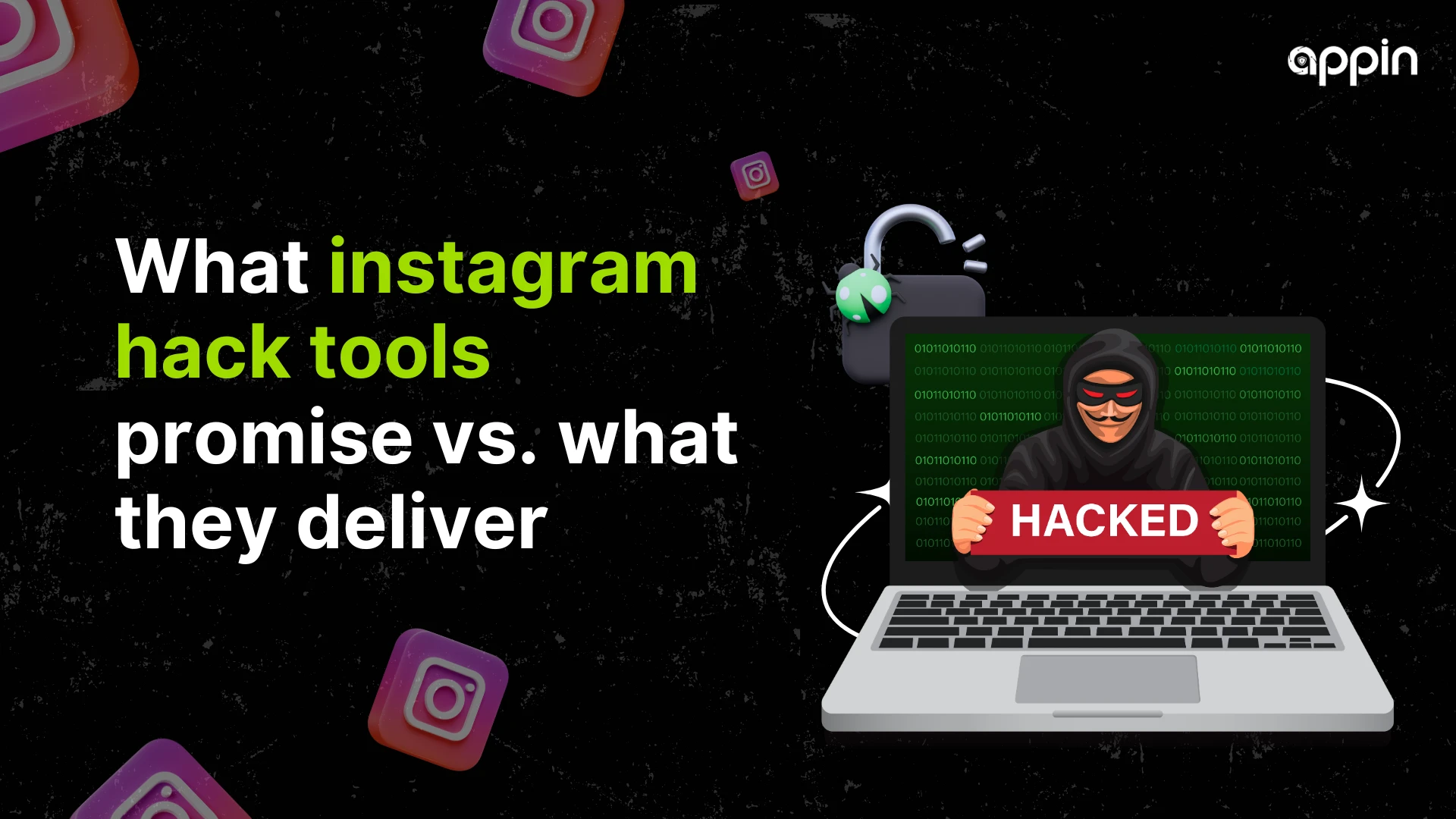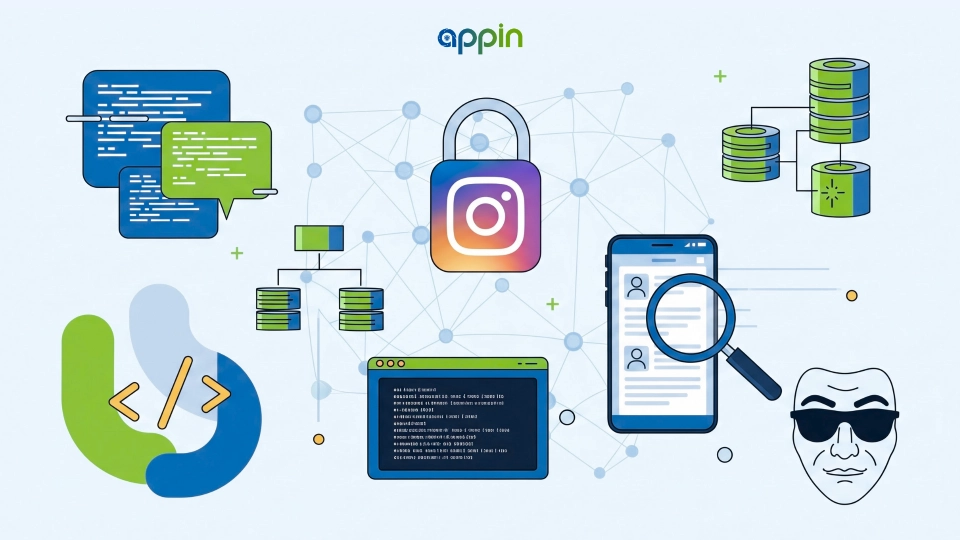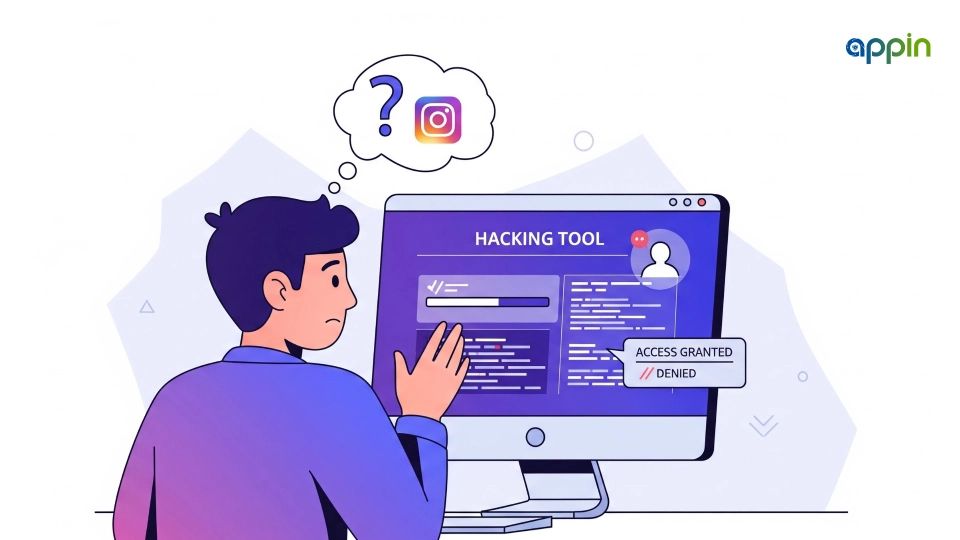Why do people search for Instagram hacking tools in the first place?
Many students and beginners search for Instagram hacking tools because they want a quick way to access someone’s account or test how secure Instagram really is. Online, you will find many websites and hacking apps for Instagram that promise instant access with just a username.
The truth is, most of these tools do not work. Many are scams designed to trick users into sharing personal data, downloading malware, or completing fake surveys. Some are nothing more than simple password guessers that fail against Instagram’s strong security systems.
Using these tools can also be illegal and dangerous. Instead of getting access to an account, students often end up risking their own privacy or facing legal trouble.
In this blog, you will learn what these tools claim to do, what they actually deliver, the risks of using them, and how ethical hacking offers a safer, smarter path.
What are Instagram hacking tools?
Instagram hacking tools are apps or websites that claim to break into Instagram accounts.
These tools are often advertised as Instagram password hacker apps or Instagram account hacking tools that can recover any account within minutes. They usually work by asking you to enter a username and then promising to reveal the password.
In reality, most of these tools are either:
- Scams that redirect you to endless ads or survey pages.
- Phishing traps that steal your email and password when you type them in.
- Brute force guessers that try random passwords but rarely succeed.
The reason they fail is because Instagram has multiple layers of security, including two-factor authentication, account lockouts, and advanced monitoring of suspicious logins. No public tool can simply bypass these protections.
Some tools also ask users to download software or APK files. These often contain malware that infects your device, steals your personal data, or spies on your activity. Instead of hacking someone else, you end up getting hacked yourself.
In short, Instagram hacking tools are not what they claim to be. They may look convincing, but they are unsafe, unreliable, and in most cases completely fake. Understanding this is the first step to protecting yourself from falling into these traps.
Why do students and beginners look for Instagram hacking tools?
Many students search for Instagram hacking tools out of curiosity, peer pressure, or the mistaken belief they can get quick access without consequences.
Curiosity and the desire to learn how systems fail are common among beginners, especially those just starting in security.
Some search because of personal reasons, such as jealousy or revenge, while others are simply experimenting without understanding the risks.
Common motives you will see online:
- Curiosity and learning — wanting to see how accounts can be compromised.
- Peer pressure or dares — friends sharing “easy hacks.”
- Revenge or spying — trying to read private messages.
- Perceived shortcuts — hoping for instant results without study.
The reality is that most so called Instagram hacking tools are traps that teach the wrong lessons. Many beginners think these tools are a shortcut to real skills. A safer, productive alternative is to channel that curiosity into training, for example a Cyber Security Certification that teaches legal testing methods and basic defensive skills.
If you are learning, focus on fundamentals such as networking basics, password hygiene, and ethical testing methods. These build real skills you can use in internships and entry level roles, and they keep you out of legal trouble.
Do Instagram hacking tools actually work?
No, most Instagram hacking tools do not work, and the real Instagram hack success rate for public tools is effectively zero.
Many sites promise instant access, but they rely on fake claims, social engineering, or browser tricks rather than any real exploit. A typical flow is: fake tool page → complete surveys or download software → nothing works, or you get phished.
What these tools usually do:
- Show fake progress to convince you it is working.
- Ask for personal data then steal it through phishing.
- Deliver malware via APK or software downloads.
- Use brute force scripts that get blocked by Instagram’s lockouts and two factor checks.
Instagram has layered protections like two factor authentication, suspicious login alerts, rate limits, and account lockouts, which make simple public tools ineffective. Claims about high Instagram hack success rate are misleading because they ignore these protections and focus on anecdotal or staged results.
If a tool claims 100 percent success, treat it as a scam. Real penetration testing requires permission, advanced skills, and safe environments. Trying random public tools will not teach you how real security testing works, and it often ends with lost data or a compromised device.
What are some Instagram hacking tools you will find online?
Online you will mostly find scam sites, malware wrappers, and a few commercial spyware apps that claim to hack Instagram but rarely deliver legitimate access.
Below are common types and example names you will see in an Instagram hack software list, with what they claim and what they actually do. This is not a how to guide, it is a reality check.
1. Phishing pages (example names: “InstaHack”, “InstaLeak”)
Claim: Enter a username, get the password instantly.
Reality: These pages capture whatever email or password you type, or force you through fake surveys. They harvest credentials, they do not bypass Instagram security.
2. Fake online generators (advertised as “free Instagram password hacker”)
Claim: Auto generate or reveal passwords for free.
Reality: They show fake progress bars, then ask for downloads or survey completions, producing no working result.
3. Brute force scripts and tools
Claim: Try many password combinations until one works.
Reality: Instagram blocks repeated attempts, triggers account lockouts, and flags IPs. Brute force from a regular computer is ineffective.
4. APK trojans and disguised apps
Claim: Install this app to “recover” an Instagram account.
Reality: APKs often contain malware or keyloggers that steal data from your device, compromising you rather than the target.
5. Commercial spyware (examples: mSpy, FlexiSPY)
Claim: Monitor messages and activity, bypass security.
Reality: These are paid monitoring tools meant for parents or businesses, they require installation and consent, and misuse may be illegal.
6. Keyloggers and remote access tools (RATs)
Claim: Capture keystrokes or remotely control a device to access accounts.
Reality: They are high risk, often illegal to deploy, and commonly flagged by antivirus software.
7. Hacker-for-hire services and social engineering gigs
Claim: Pay someone and they will get into an account for you.
Reality: Many are scams that take money and vanish, or they involve illegal activity that can lead to prosecution.
8. “Password reset” scams
Claim: Bypass verification to reset passwords.
Reality: These attempts usually require access to the target’s email or phone; without that, the methods fail and may expose you to fraud.
Practical note: If you are studying tools to learn how attacks work, do it in a controlled way and with permission. A formal course such as Certified Ethical Hacking teaches safe, legal testing techniques and explains how to spot these scam tools without putting you at risk.
Understanding what appears in a typical Instagram hack software list helps you spot scams, avoid malware, and choose legal learning paths instead of risky shortcuts.
Are Instagram hacking tools legal to use in India?
No, attempting to hack someone’s Instagram account without their permission is illegal in India.
Using or even trying Instagram hacking tools against another person’s account violates privacy and can lead to strict penalties. In India, the Information Technology (IT) Act, 2000 clearly defines unauthorized access to computer systems and online accounts as a punishable offense.
Here is what the law says:
- Section 43A and Section 66 of the IT Act make it illegal to access, steal, or misuse digital information.
- Penalties can include fines ranging from ₹1 lakh to several lakhs.
- Serious cases can result in imprisonment of up to 3 years, or both fine and jail time.
Even if someone claims to be testing a tool “just for fun,” the law does not differentiate. Without written consent from the account owner, any attempt is considered unauthorized access. This makes most uses of these tools both unsafe and illegal.
It is also worth noting that promoting or selling such tools online can lead to additional charges. Law enforcement in India has already taken action against people running phishing sites or fake hacking services.
If you are interested in understanding how platforms like Instagram defend against attacks, the legal and professional way is through ethical hacking courses such as the C|EH v13 Ethical Hacker Course, where you learn testing methods in a controlled, authorized environment.
What risks do you face if you try these tools?
Using Instagram hacking tools exposes you to technical, legal, and personal risks that can harm your device, your privacy, and even your future career.
Some of the major risks include:
- Malware and viruses: Many free downloads or APKs are loaded with trojans, spyware, or ransomware. Once installed, they can steal banking details, personal files, or even lock your device.
- Phishing scams: Fake hacking websites often ask for your own email and password, tricking you into giving away your credentials. This leads to identity theft or loss of your own Instagram account.
- Legal consequences: Under the IT Act in India, trying to hack an account without permission can result in fines and jail time. Even “testing” tools without consent is punishable.
- Account lockouts: Repeated failed login attempts from brute force scripts can cause Instagram to temporarily or permanently lock accounts.
Instead of gaining access, you end up losing control of your own data. Many students who use these tools realize too late that they became the victim, not the hacker.
For those curious about testing security, a safer option is structured training like a Bug Bounty Diploma, which teaches how to find vulnerabilities in a legal environment and rewards you for reporting them.
How do ethical hackers test Instagram security safely?
Ethical hackers test Instagram security by using authorized methods such as penetration testing and bug bounty programs.
Unlike scammers, ethical hackers never try to steal accounts. Instead, they analyze systems in controlled environments with written permission. The focus is on finding weaknesses and reporting them responsibly.
Here are safe ways ethical hackers work:
- Penetration testing: Simulating real attacks against apps or websites in a lab setup to understand possible risks.
- Bug bounty programs: Platforms like Facebook (which owns Instagram) invite researchers to report security flaws and pay rewards for valid findings.
- Security research tools: Using authorized scanners and frameworks under guidelines, not public “free Instagram hacking tools.”
This approach not only keeps you legal, it also builds credibility. Companies respect security researchers who follow rules, and many professionals have built careers through these programs.
Learning ethical Instagram hacking in a structured way helps you gain real skills such as penetration testing Instagram systems and protecting user accounts. These skills are valuable for cybersecurity jobs and far more rewarding than trying risky shortcuts.
What is the safest way to build skills instead of relying on fake hacking tools?
The safest way to learn about Instagram security is by avoiding fake hacking tools and focusing on ethical hacking training.
Throughout this blog, you have seen that Instagram hacking tools are unsafe, unreliable, and often scams. They do not deliver what they promise, they put your personal data at risk, and they can even land you in legal trouble.
The smarter choice is to pursue training that equips you with real, employable skills in cybersecurity. With courses that cover testing, defense strategies, and responsible reporting, you gain the knowledge to build a career while staying within the law.
If you are serious about learning ethical hacking and building a future in cybersecurity, enquire now with Appin to start your journey.




